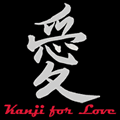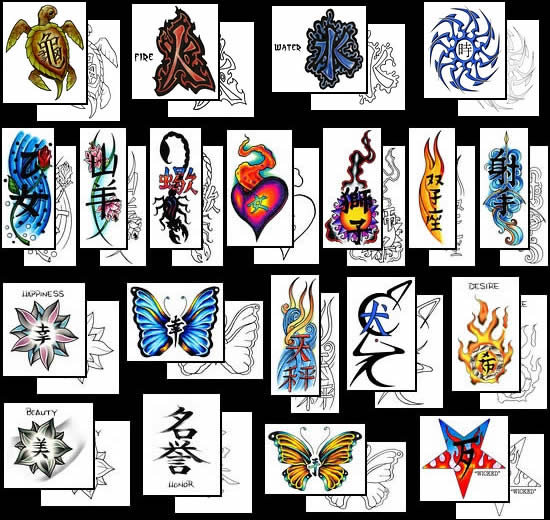|
|
|||
 |
|||
|
TATTOO DESIGNS & SYMBOLS - KANJI TATTOOS
Tattoo Symbol Index - A B C D E F G H I J K L M N O P Q R S T U V W X Y Z
Tattoo designs - K >> Kanji Kanji Tattoos - Literacy began in Japan in the 4th century AD, when they borrowed pictograms from the Chinese and the Koreans, a system of characters called ‘hanzi’. The Japanese called them kanji, meaning ‘han characters’, and they survive to this day as part of the Japanese writing system.
The Japanese kanji ideograms, like the Egyptian hieroglyphs, convey ideas in a pictorial form. They provide the root and core meaning of most nouns, adjectives and verbs. Hiragana symbols are often added after kanji as grammatical modifiers. For example, the Japanese kanji character for ‘eat’ could be modified to mean ‘to eat’, ‘ate’, or ‘eating’, by changing the hiragana characters that follow. But what makes kanji especially difficult to learn is, first of all, the sheer number of symbols – 1000 needed to read the newspaper. Japanese school children must learn this basic vocabulary by the sixth grade. Almost two thousand kanji are in everyday use, and about 3500 characters are at the disposal of the well-educated Japanese person. And once you’re versed in the vocabulary, there’s the problem of context in which each character finds itself, which can alter its pronunciation.
Lyle Tuttle, arguably the most important tattooist in the modern history of the tattooing, has long rejected requests to do ‘kanji’. He doesn’t trust what he doesn’t know, and what might take a lifetime to master. Built not on alphabetical letters but pictographs consisting of up to 30 strokes of the calligrapher’s pen, kanji is a complex system in which each character can potentially entertain more than one ‘reading’. Determining which of its possible meanings applies, requires enough linguistic knowledge to accurately analyse the context. Some kanji can have up to ten interpretations. So, if you don’t speak Japanese, how do you know for certain that your choice of kanji says what you intend, and isn’t going to be the source of eternal embarrassment? There’s a website entirely ‘dedicated to the misuse of chinese characters in western culture’ (www.hanzismatter.com). Nevertheless, the passion for turning a nationality into a commodity shows no signs of abating. Why? Because of ‘the way of writing.’ Calligraphy. The Japanese call it shodo. Kaisho is the angular block script commonly used for Japanese kanji tattoos, but never in everyday use. But kanji may be written in the less legible script called sosho (cursive) or gyosho (semi-cursive), depending on how loose and flowing the client feels is right for him or herself. After all, choosing a text style (font) is always a reflection of personality, no less than choosing the thought the kanji conveys. In fact, some shodo masters insist that you don’t necessarily have to know the meaning of a written symbol, since what matters most in calligraphy is the line and rhythm. They are reflections of the state of mind. You might say that the wearer of a text tattoo is literally ‘writing their heart on their sleeve.’ Consider the training that a Japanese calligrapher traditionally undergoes, working under a master’s ruthless eye. Each stroke of the pen follows a prescribed order, never is it arbitrary. If a single mistake is made, the student must begin again on paper that’s expensive, using ink that’s painstakingly made by hand. Practicing under such extreme pressure, the apprentice must locate that place deep inside that’s immune to shame. In other words, the student learns to conquer doubt, and in the process discovers the truth of the mystic’s claim that ‘true victory is victory over oneself’. Look for haiku tattoos to take kanji to new heights of popularity. A haiku is a poem consisting of only a few syllables that ‘captures the moment’. For example: “A world of grief and pain. Flowers bloom. Even then.” Take Lyle Tuttle’s advice and find a native speaker of Japanese to design your haiku. Because bad kanji can take you new depths of humiliation. Get Kanji designs on t-shirts, hats, sweatshirts, bags & more. Check out all these different Kanji tattoo design ideas by some of the world's top tattoo artists and flash illustrators. Tattoo designs - K >> Kanji
Tattoo Symbol Index - A B C D E F G H I J K L M N O P Q R S T U V W X Y Z |
||
Tattoo Designs provided by TattooJohnny.com |
|||
| Celeb Tattoos | Facts & Stats | Designs & Symbols | History | Culture | Links | Tattoo Galleries | Contact | |||
|
|
|||

 How popular are kanji tattoos? They account for nearly 20% of all Internet tattoo design searches. The idea of expressing a soulful feeling with such an exotic symbol is highly attractive. And the pitfalls are legend. For starters, kanji is not a traditional Japanese tattoo. It’s virtually unknown in Japan. But it’s a tattoo style that has become popular among Westerners who believe that kanji identifies them with an Eastern philosophy based on geishas and cherry blossoms. Not! As a foreign writing system, kanji is a minefield lying in wait for the unsuspecting Westerner.
How popular are kanji tattoos? They account for nearly 20% of all Internet tattoo design searches. The idea of expressing a soulful feeling with such an exotic symbol is highly attractive. And the pitfalls are legend. For starters, kanji is not a traditional Japanese tattoo. It’s virtually unknown in Japan. But it’s a tattoo style that has become popular among Westerners who believe that kanji identifies them with an Eastern philosophy based on geishas and cherry blossoms. Not! As a foreign writing system, kanji is a minefield lying in wait for the unsuspecting Westerner. 
